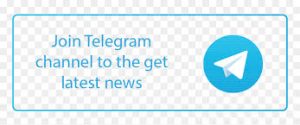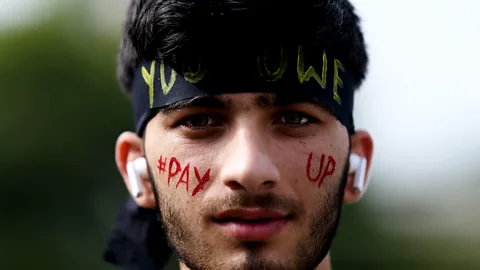 Getty Images
Getty ImagesAs countries negotiate a new global goal to raise climate cash, these five charts show why discussions are so fraught.
This may sound like a lot, but it is already considered too little. The new number that’s being floated by many developing countries: at least a trillion.
Climate negotiators at COP29 in Baku, Azerbaijan, are discussing the details of how much money rich countries should provide to poor countries to help them mitigate emissions and cope with climate impacts. What they haven’t decided yet is how much it will be – or many of the other details, such as the target date to deliver the money and who will contribute. A huge range of options have been put forward by different groups and countries.
The question is ultimately one of justice, those countries say. Richer nations have, after all, historically caused the lion’s share of climate change. Poorer nations not only have less means to make costly climate adaptations, but the problem of climate change was also largely not of their making. (Read more about the world’s fight for climate justice).
Climate finance is “not charity”, Ani Dasgupta, president of the World Resources Institute, a non-profit based in Washington DC, told a press briefing ahead of COP29. It is needed for the world to be “in a better place,” he said, adding: “Developing countries cannot meet their transition goals if there is no finance.”
As talks continue in Baku, here are five key charts to help put the fraught discussions into context – and show what is really at stake.
What‘s been paid so far?
Money is a tough topic that has caused a lot of tension at climate talks for decades now, even as climate costs around the world continue to rise.
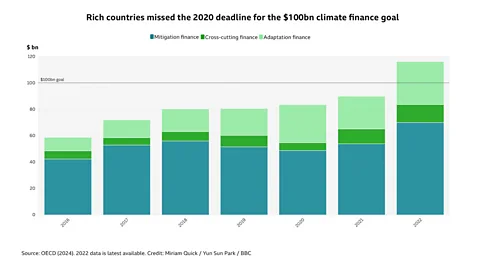 Miriam Quick / Yun Sun Park / BBC
Miriam Quick / Yun Sun Park / BBCSpeaking at COP29, UN climate chief Antonio Guterres said “now more than ever” finance promises must be kept. “Developing countries eager to act [on climate change] are facing many obstacles: scant public finance; raging cost of capital; crushing climate disasters; and debt servicing that soaks up funds,” he said. “We need a new finance goal that meets the moment.”
If the new climate finance goal fails, we will all feel the impact, says Charlene Watson, senior research associate at Overseas Development Institute (ODI), a global think tank based in London, UK. “It [would be] a global failure. We are all not reaching the global 1.5C target.” (Read more about why 1.5C is a critical threshold for the climate).
Why do we need a new finance goal?
The $100bn goal, which was announced 15 years ago at a previous conference, COP15, is “now clearly out of sync with the total needs” of developing countries, says Joe Thwaites, senior advocate in international climate finance at the Natural Resources Defense Council (NRDC), a US non-profit.
The only conditions fully agreed so far for the new goal are that it will be “from a floor of $100bn per year” and “take into account the needs and priorities of developing countries”.
The original $100bn goal, in contrast, was a political number, says Watson. “It wasn’t a number that was based on developing country needs. The [new goal] is supposed to be based on those needs. And those needs are just tremendous.”
What’s actually needed?
It’s hard to say exactly what reducing emissions and coping with climate impacts has already cost developing countries or will cost in the future. This has led to huge range of estimates of the money that is needed via the new goal.
The chart below shows the large range in estimates of annual climate finance needs in developing countries by 2030. Even though estimates of what’s needed are “not perfect”, adds Thwaites, “they do show that total needs are in the trillions of dollars per year”.
 Miriam Quick/ Yun Sun Park/ BBC
Miriam Quick/ Yun Sun Park/ BBCAhead of the current talks, some developing countries and groups of developing countries put “very big numbers on the table”, says Watson. “They want the goal to look like a trillion [dollars per year],” she says. “Developed countries haven’t yet officially put a quantum on the table, so we don’t know how much bigger than $100bn it’s going to be.”
An expert group of economists established by the COP26 and COP27 presidencies has similarly recommended that rich countries spend $1tn (£785bn) annually by 2030 on climate and nature investments in developing countries, out of $2.4tn (£1.88tn) in total needs in these countries.
But this calculation does not take into account China’s financial needs. China is considered to be a developing country in the UN climate process, this makes the economists’ calculation “a difficult number to try and use in a [final COP] decision”, says Thwaites.
How $100bn compares to fossil fuel earnings
Oil and gas earnings soared from 2022 due to the surging price of oil and gas following Russia’s full-scale invasion of Ukraine. In 2023, the world’s largest five fossil fuel companies paid their shareholders $111bn (£87.4bn), according to analysis by Global Witness, a non-profit with offices in London and Washington DC. BP and Shell both reported their second highest annual profit in a decade in 2023, a total of $13.8bn (£11bn) and $28.2bn (£22.3bn) respectively.
Fossil fuel companies’ revenues, combined with soaring coal, oil and gas emissions, have led some groups to suggest sourcing climate finance directly from the fossil fuel sector.
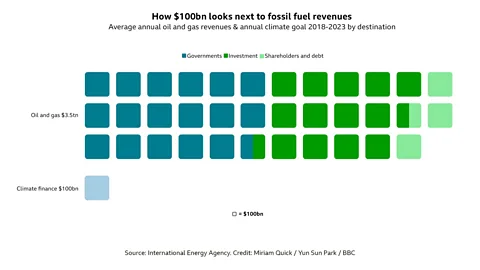 Miriam Quick / Yun Sun Park / BBC
Miriam Quick / Yun Sun Park / BBCHow the $100bn compares to climate damage
Developing countries are often especially hard hit. While overall financial losses tend to be greater in richer countries, poorer countries see higher shares of GDP loss. These countries also suffer the most in terms of lives lost and disrupted.
Such losses are only set to get worse. A 2018 paper found that the loss and damage due to climate change in developing countries will reach $290-580bn (£228-456bn) in 2005 money by 2030, equivalent to $468-936bn (£368-737bn) today. These damages could more than triple by 2050, it found.
 Miriam Quick/ Yun Sun Park / BBC
Miriam Quick/ Yun Sun Park / BBCDamage to farming, infrastructure, productivity and health around the world will cost $38tn (£30bn) per year by 2050, according to analysis by the Potsdam Institute for Climate Impact Research in Germany. Climate change has already committed the world economy to an income reduction of 19% up to 2050, the researchers concluded.
A Marshall plan for the climate?
The unprecedented scale of the climate challenge has led some to call for a green Marshall plan. The idea refers to the US programme to help fund Europe’s recovery after World War Two. The US forked out $13.6bn (£10.7bn) in 1948 in economic aid, equivalent to around 5% of its GDP at the time.
“I have some sympathy with analogies of the Marshall plan,” says Thwaites. “It is a helpful framing in the sense that is shows that human societies are able to organise themselves and mobilise massive amounts of resources”.
However, the Marshall plan only covered a few years, while most people see the climate finance effort as needing to go “probably to mid-century”, Thwaites says.
One of the biggest debates over the last few years has been who is going to contribute to the new fund, says Watson. The previous $100bn goal was agreed to by 23 developed countries and the EU, and notably didn’t include China, now the world’s largest polluter.
Many developed countries think some of the increasingly wealthy developing nations should be contributing to the new finance goal. “[They] want to see very specific provisions for who needs to contribute,” says Watson. It’s worth noting that many developing countries, including China, already provide some international climate finance, but that this is currently not counted towards the climate finance goal.
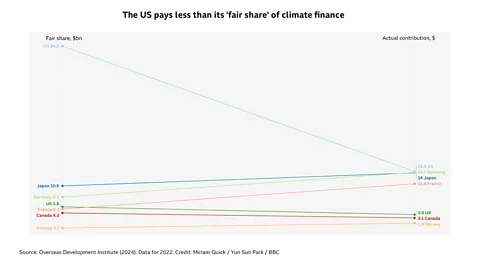 Miriam Quick / Yun Sun Park/ BBC
Miriam Quick / Yun Sun Park/ BBCBig emitters’ failure to pay their fair share has led to “a lot of anger and frustration and a lack of trust and confidence”, says Sarah Colenbrander, director of the climate and sustainability programme at ODI.
“America just repeatedly fails to deliver,” says Watson. Climate experts also now see a Trump presidency as a major setback for global climate action and a huge roadblock to raising critical funds for climate vulnerable countries.
Even without US leadership, though, debates on finance will continue to be a huge focus in Baku and future climate talks.
“In the future, all COPs will be about finance,” says Dasgupta. “That is where we need to come to an agreement and where the question of justice looms largest.”

